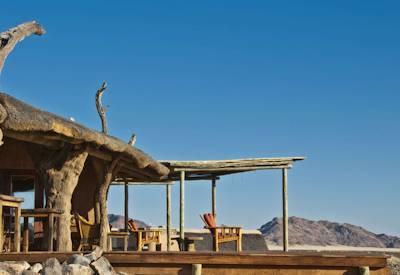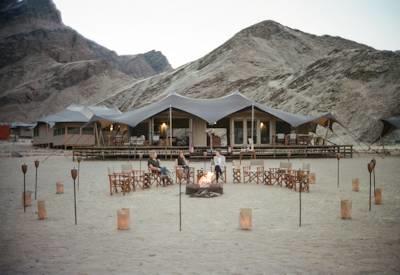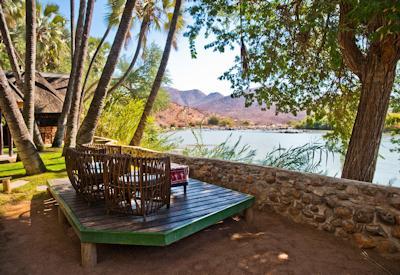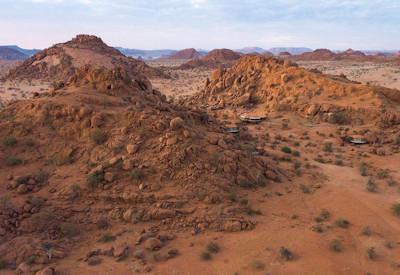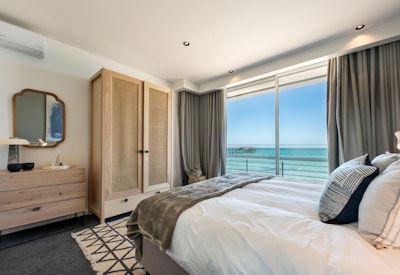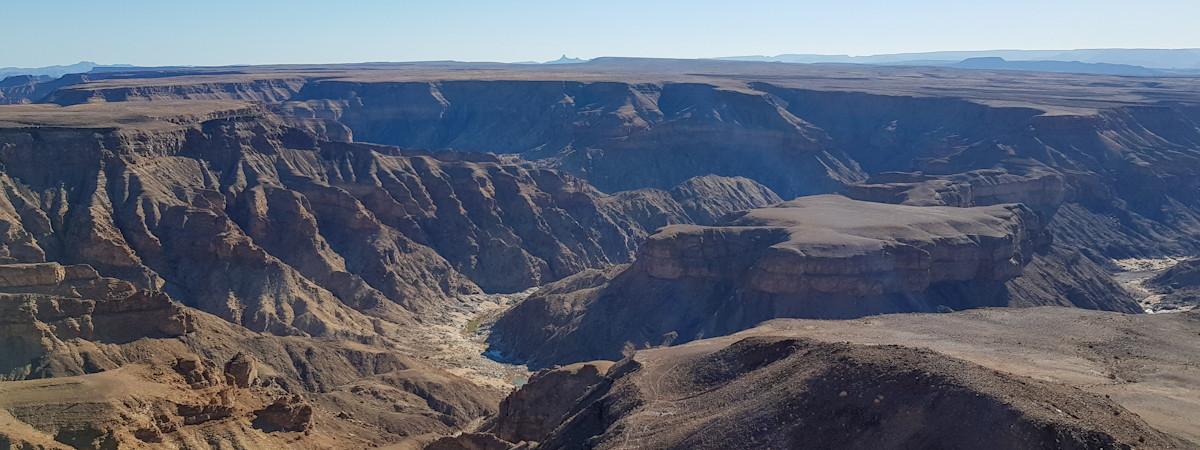
Fish River Canyon
Absolutely magnificent and breathtaking in its immensity, The Fish River Canyon in Namibia is the second largest canyon in the world. Formed by water from the Fish River flowing through an arid environment over millions of years, the landscape here is desolate, dusty and rock-strewn with enticing hills and chasms.
Fish River Canyon Facts
- Size: 160km long, up to 27km wide and up to 550m deep
- When to visit: Year-round
- Rainfall: Erratic, 10mm to 40mm per annum, varying with flash floods occurring often
- Altitude: varies from 366m to 609m above sea level
- Location: South-Eastern Namibia
- Accommodation: Lodges near Fish River Canyon
Information On Fish River Canyon
Absolutely magnificent and breathtaking in its immensity, The Fish River Canyon in Namibia is the second largest canyon in the world.
Formed by water from the Fish River flowing through an arid environment over millions of years, the landscape here is desolate, dusty and rock-strewn with enticing hills and chasms. It is surrounded by high, forbidding cliffs, and winds along a distance of approximately one hundred miles through the fissured Koubis Massif all the way down to the sulphurous Ai-Ais Hot Springs. The fantastic views of this majestic canyon make it a popular hiking destination, and there is a terrific 5 day, 86 km trek along the canyon floor.
After heavy rainfall, The Canyon quickly turns into a raging river although it usually carries only a small amount of water, being dammed up in the town of Hardap. The main viewpoint for the Canyon is at Hobas near the northern end of the canyon. The 60ºC sulphurous springs at Ais-Ais (from the Nama word meaning 'burning water') originate deep underground and are rich in minerals which are reputedly beneficial for those with rheumatic or nervous disorders. Ais-Ais falls within the Fish River Canyon conservation area, and the hot springs are a public facility.
The fantastic 5-day hike offers thrills to adventure seekers and travellers alike. Absolutely no facilities are provided, and you carry everything with you and find whatever water you can in semi-permanent pools. Due to the risk of flooding and the high summer temperatures, the hiking trail is only open from May 1st to August 31st.
Wildlife, while not as concentrated here as in other areas (such as Etosha and Caprivi), do include troops of Chacma baboons and isolated groups of klipspringers while mountain zebra and kudu are rare. The area attracts an interesting variety of colourful birds and raptors such as rock kestrels, and lanner falcons ride the thermals.
Where is Fish River Canyon located?
Located within the /Ai / Ais-Richtersveld Transfrontier Park (Namibia and South Africa), the canyon though is situated in the southeastern region of Namibia.
- Luderitz to Hobas = 418km
- Luderitz to Ais-Ais = 458km
- Sesriem to Hobas = 568km
- Sesriem to Ais-Ais = 630km
- Vioolsdrif (South Africa/Namibia border post) to Hobas = 168
- Vioolsdrif (South Africa/Namibia border post) to Ais-Ais = 121km
Here is a link to a map of the canyon; Google Maps - Fish River Canyon
Best Time to Visit Fish River Canyon?
One can visit the canyon year-round, although it must be noted that the summer months can be exceptionally hot, with temperatures in the late 30's and early 40's (degrees Celcius).
Winter mornings can be very cold, with temperatures dropping below zero (degrees Celcius).
If you are not affected by heat, look at the Fish River canyon as a year-round destination, but if you are looking to avoid the heat, look at the winter and autumn months (June to October).
Main Attractions Of Fish River Canyon
- The second-largest canyon in the World
- Stunning views, especially at sunrise and more so, sunset
- 86km Fish River Canyon hike
- Therapeutic hot springs at Ais-Ais
- Sunsets drinks at the viewpoint near Hobas
- Atlantic Villa Guesthouse
Atlantic Villa Guesthouse, located in the peaceful Vogelstrand area of Swakopmund, offers a coastal retreat just 6 km from the town centre. With stunning views of the Atlantic Ocean, it's a tranquil and luxurious escape.
With its enviable location just a short stroll from the ocean's edge, Atlantic Villa combines convenience with the unparalleled beauty of Swakopmund's coastline, making it the perfect haven for those seeking relaxation and elegance by the sea.
- Kulala Desert Lodge
Kulala Desert Lodge, located in the stunning Namib Naukluft Park on the 37,000-hectare Kulala Wilderness Reserve, is the closest lodge to Sossusvlei's iconic red dunes. It's the perfect base to explore Namibia's extraordinary landscapes and capture early-morning shots of Deadvlei's unique beauty.
This desert safari lodge features 23 beautifully designed thatched and canvas suites, each with en-suite bathrooms, private star beds for unforgettable nights under the desert sky, and spacious verandas to enjoy stunning views. The luxurious yet authentic experience is truly remarkable.
- Hoanib Valley Camp
Hoanib Valley Camp, set in the stunning landscapes of Kaokoland/Damaraland, offers a unique experience amidst Namibia's incredible desert wildlife. Spot desert lions, elephants, rhinos, giraffes, hyenas, oryx, and mountain zebras—all thriving in this dramatic desert.
The Hoanib River Valley in Namibia's Damaraland is breathtaking. Surrounded by rugged mountains, it offers stunning scenery and a haven for unique desert wildlife. Staying here is an unforgettable safari adventure into Namibia's wild and remote beauty.
- Omarunga Lodge
Epupa Falls is, without a doubt, one of the most breathtaking highlights of northern Damaraland in Namibia. Nestled along the tranquil banks of the Kunene River lies the enchanting Omarunga Lodge, a serene retreat offering an unparalleled connection to nature.
What makes this location even more extraordinary is its proximity to the stunning Epupa Falls. Just a leisurely 2-minute stroll from the lodge, you’ll find yourself standing above the cascading waters, mesmerised by their beauty.
- Onduli Ridge
Set in the rugged beauty of Damaraland, Onduli Ridge is a serene retreat for travellers seeking both comfort and adventure. The lodge offers stunning views of Namibia's granite outcrops and desert plains, creating a perfect connection to nature.
At Onduli Ridge, the experience is as unique as the surroundings. Guests have the opportunity to explore the enchanting terrain on guided walks or game drives, with the chance to encounter the elusive desert-adapted elephants.
- The Pearls Beach Pods
The Pearls Beach Pods stand on Namibia's desert coastline near Swakopmund as an attractive destination for travellers. The pod accommodations at The Pearls Beach Pods deliver both comfortable relaxation and exciting outdoor adventures to travellers who want peaceful accommodations while discovering Namibian natural attractions.
A visit to The Pearls Beach Pods will deliver an unforgettable encounter for every occasion. The modern pods at The Pearls Beach Pods provide the ideal retreat for families on safari, couples on honeymoon, or anyone seeking beach relaxation.


